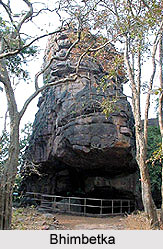 Bhimbetka, the rocky terrain covered by dense forest, surrounded by the northern fringe of the Vindhyan ranges, situated to the south of Bhopal has over five hundred caves where the prehistoric cave-dwellers painted vividly. These caves, which are recently discovered, were biggest shelter of prehistoric men. The caves here are in true sense `The portal to the ancient gallery of Bhimbetka`, which preserves the fascinating paintings dating back to the Paleolithic times.
Bhimbetka, the rocky terrain covered by dense forest, surrounded by the northern fringe of the Vindhyan ranges, situated to the south of Bhopal has over five hundred caves where the prehistoric cave-dwellers painted vividly. These caves, which are recently discovered, were biggest shelter of prehistoric men. The caves here are in true sense `The portal to the ancient gallery of Bhimbetka`, which preserves the fascinating paintings dating back to the Paleolithic times.
The Bhimbetka caves are archeological treasure and an invaluable chronicle in the history of man. Bhimbetka is always referred whenever Indian rock art is alluded to. V.S.Wakankar discovered the caves of Bhimbetka. It derives its name from the early epic Mahabharata on the name of second Pandava, Bhima.
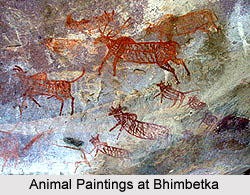 The paintings are executed mainly in red and white with the occasional use of yellow and green. The themes taken from everyday life describing scenes of hunting, dancing, horse and elephant riders, animals fighting, honey collection, decoration of bodies, masks and household works. Animals such as bison, tiger, lion, wild boar, elephant, antelope, dog, crocodile etc animals were included within the pictures. Popular religious and ritual symbols also occurred frequently in the pictures. The cultural traditions of the inhabitants of the twenty-one villages adjacent to the site bear a strong resemblance to those represented in the rock paintings.
The paintings are executed mainly in red and white with the occasional use of yellow and green. The themes taken from everyday life describing scenes of hunting, dancing, horse and elephant riders, animals fighting, honey collection, decoration of bodies, masks and household works. Animals such as bison, tiger, lion, wild boar, elephant, antelope, dog, crocodile etc animals were included within the pictures. Popular religious and ritual symbols also occurred frequently in the pictures. The cultural traditions of the inhabitants of the twenty-one villages adjacent to the site bear a strong resemblance to those represented in the rock paintings.
On the walls of the caves hundreds of images are painted, often superimposed upon one another constitutes a spectacular canvas. Three main periods are recognized by the Indian researchers namely Mesolithic era, Chalcolithic era and historical period. The place is included under UNESCO World Heritage List in the year 2003. In words of famous researcher Yashodar Mathpal(1998) the all of the paintings can be narrated with their typical characteristic. He said, " If one visits a painted shelter, one is confronted with two types of drawings- one is very clear fresh looking, while the others underlying them are faded, fragmented and hardly visible.
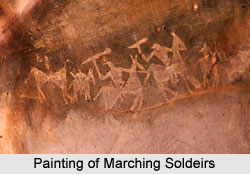 The fresh ones feature mainly bands of marching and fighting soldiers, cavaliers being chased and aimed at by masked hunters equipped with bows and arrows and barbed spears. In between these two types of figures sometimes we find a third category. These are of long-horned cattle, other domesticated animals and men engaged in activities which can be associated with a primary stage of civilization-the beginning of sedentary life."
The fresh ones feature mainly bands of marching and fighting soldiers, cavaliers being chased and aimed at by masked hunters equipped with bows and arrows and barbed spears. In between these two types of figures sometimes we find a third category. These are of long-horned cattle, other domesticated animals and men engaged in activities which can be associated with a primary stage of civilization-the beginning of sedentary life."
Mathpal divided the chronicle of art in nine phases altogether, among which the first five phases are prehistoric, depicting the life and environment of the hunters.
Phase One (Upper Paleolithic) : This involves the pictures of large sized animals like buffaloes, elephants, wild bovid and big cats, which are outlined and partially in filled with geometric and labyrinth pattern. No human figure is seen in this phase.
Phase Two (Mesolithic) : Petite figures of animals and human are seen in this phase, which are full of life and naturalistic elements. Hunters are mostly in groups. Among animals deers are the dominant ones. The colors used are red and white in most cases. An emerald green figure is also found which is a S-shaped human body in dancing position.
Phase Three (Chalcolithic) : Large size animals with vertical strips are found, also there are evidences of some human figures.
Phase Four : The figures are mostly schematic and simplified in this phase.
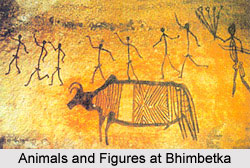 Phase Five : The animals and figures in this phase are drawn with a complex decorative pattern. The large-horned animals are painted with fine thin lines with their body decorated in honeycomb, zigzag and concentric square pattern.
Phase Five : The animals and figures in this phase are drawn with a complex decorative pattern. The large-horned animals are painted with fine thin lines with their body decorated in honeycomb, zigzag and concentric square pattern.
The sixth phase marks a transitional period, which indicates the beginning of agricultural life.
Phase Six : This is quite different from the previous ones. The figures are more conventional and schematic. Bodies of animals are painted in a rectangular shape with stiff legs. The bovine animals are drawn with humps on their back and horns at the tip of head. Chariots and carts with yoked oxen give hints to the advancement of civilization.
Phase seven to nine clearly distinguish the historic era.
Phase Seven : This phase depicts the riders on horses and elephants. The group dancers are painted in thick red and white colors, who according to Mathpal "decine in artistic merit."
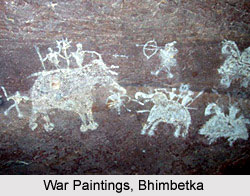 Phase Eight : In this phase bands of marching and facing soldiers are painted, with their chiefs riding elephants and horses. The soldiers are equipped with long spears, swords, bows and arrows. They have rectangular shields in their hands, which are little carved. Horses are elaborately decorated and dressed up. All these are painted with red outline and white infilling.
Phase Eight : In this phase bands of marching and facing soldiers are painted, with their chiefs riding elephants and horses. The soldiers are equipped with long spears, swords, bows and arrows. They have rectangular shields in their hands, which are little carved. Horses are elaborately decorated and dressed up. All these are painted with red outline and white infilling.
Phase Nine : This phase depicts geometric human figures and designs and also various known religious symbols and inscriptions.
Out of the 817 human figures recorded, 779 are identified as men, rests 21 are women and 16 are children. There are 428 animals in total, which are dominated by horses (185 in number), followed by deer (39) and bovid (37). There are also other animals painted rarely like dogs, tigers, buffaloes, panthers, monkeys etc.
It is a wonder why these paintings have not been faded out in course of thousands of years. It is believed that paints were made of natural materials like colored earth, vegetable dyes, roots and animal fat. Brushes were made of pieces of fibrous plants and twigs of trees. The colors have been remarkably well preserved because of the natural red and white pigments used.
The vegetable colors used are so enduring because the drawings are generally made deep inside a niche or on the inner walls of the caves.The oldest of the paintings are believed to be twelve thousand years old but some others are dated to as recent as medieval period. The oldest paintings are of Paleolithic ages, which are derived by the archaeologists through carbon dating technique. pt sufficiently away not to cause any damage. Guards provide information whenever necessary and see to it that the regulations are not broken.
More on Bhimbetka
Rock Shelters of Bhimbetka



















